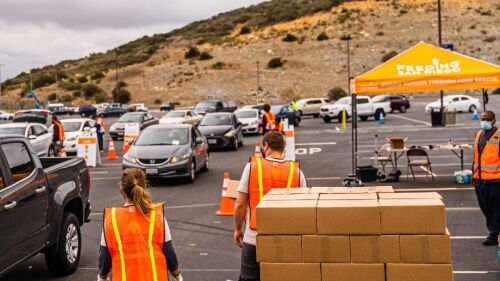Editor’s Note: Hi, Sophie Cloonan here again — intern for SDtoday. I’m so happy to share another story with you, a historical piece this time. I hope you enjoy this San Diego stadium history lesson. ✏️
From Balboa Stadium + San Diego Stadium to Petco Park, San Diego has seen its share of pro sports arenas. Beginning in 1967, the center of local sports was along Friars Road in Mission Valley, where greats like Dan Fouts, Charlie Joiner, Tony Gwynn + Trevor Hoffman took the field. In just under three weeks, that very site will start a new chapter as Snapdragon Stadium, and become the home for the San Diego State University Aztecs — and other local teams. 🏟️
With so much stadium talk around the city, let’s look at the history + evolution of our local stadiums.
Balboa Stadium, 1914-1967
Balboa Stadium was originally built as part of the Panama-California Exposition with a capacity of 15,000 seats. In 1961, the Chargers were brought to San Diego from Los Angeles to give our city its very own football team (but let’s not go too far down this road, still salty here). An upper deck was constructed to expand capacity to 34,000 seats, and on Aug. 6, 1961, the San Diego Chargers played their first game here. The Bolts played at Balboa Stadium until December 1966. ⚡
San Diego Stadium, 1967-1981
From its construction, San Diego was shooting big with this sports hub. With plans to house two football teams — and eventually, a baseball team — San Diego Stadium needed to also accommodate a growing fanbase. According to Stadium Database, designers and builders set out to create the first “octorad” shape, a unique design that featured a rounded square and was compatible with both baseball + football. 🏉

A group tailgates outside “The Murph” to get a glimpse of the 1992 All-Star Game. | Photo via @vauult + Charles Starr
Jack Murphy “The Murph” Stadium, 1981-1997
Named one of the best-looking stadiums of its time, “The Murph” housed the Chargers + Padres, hosted an All-Star game, the Holiday Bowl, and even Super Bowl XXII (1988) and a World Series (1984). With its still revolutionary octorad design, a 10,000-seat addition + the excitement of San Diego sports, there was no better place to sit and watch a game. ⚾
Qualcomm Stadium, 1998-2017
In its 20-year history, Qualcomm Stadium scored a place in the hearts of local fans. Home to the Chargers, Padres, SDSU Aztecs + the Holiday Bowl, “The Q” also served as a hub for concerts, soccer games, AFL games, and weekend markets.This stadium hosted two Super Bowls during its life — 1998 + 2003 — and two games of the 1998 World Series. ⚽
San Diego County Credit Union bought the naming rights in 2017, ushering in SDCCU Stadium. In 2021, the venue was demolished to make way for something new.
The Mission Valley site — now owned by SDSU — will open as Snapdragon Stadium on Sat., Sept. 3. In addition to being home to the Aztecs, the San Diego Legion rugby team + San Diego Wave FC will also play at Snapdragon; the NWSL expansion team’s first match at the new digs is on Sat., Sept. 17. 🐉

Pregame at Petco Park 2022. | Photo via @boronadophotography
Petco Park, 2003-Present
America’s Finest City said hello to a new sports hub in 2003. The Padres moved downtown and found a home at Petco Park. After renovations in 2015, this ballpark boasts the third largest video screen in the MLB, 42,000+ seats, and dozens of local craft brewing concessions and local restaurants. 🌭
Oh, and no big deal (but really, really big deal), Petco Park has the distinction of being named USA Today’s No. 1 MLB stadium in the US in 2022. 🥇
Up next: The Padres play at home from Thurs., Aug. 18-Sun., Aug. 21, against the Washington Nationals, then against the Cleveland Guardians on Tues., Aug. 23 + Wed., Aug. 24. The club has 13 home games at Petco Park next month, too.
Catch the team’s final home games of the 2022 regular season against the Chicago White Sox on Sat., Oct. 1 + Sun., Oct. 2, and a three-game stretch against the San Francisco Giants from Mon., Oct. 3-Wed., Oct. 5.
And keep cheering as our new high profile players — ahem, Juan Soto, Josh Bell + Brandon Drury — continue to hit ripples into the National League West.










